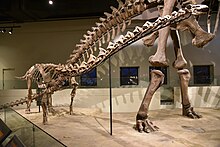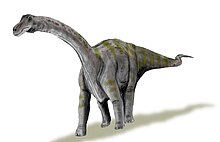Rapetosaurus
| Rapetosaurus | |
|---|---|

| |
| Juvenile skeleton, Field Museum of Natural History | |
| Scientific classification | |
| Domain: | Eukaryota |
| Kingdom: | Animalia |
| Phylum: | Chordata |
| Clade: | Dinosauria |
| Clade: | Saurischia |
| Clade: | †Sauropodomorpha |
| Clade: | †Sauropoda |
| Clade: | †Macronaria |
| Clade: | †Titanosauria |
| Clade: | †Lithostrotia |
| Genus: | †Rapetosaurus Curry Rogers & Forster, 2001 |
| Species: | †R. krausei
|
| Binomial name | |
| †Rapetosaurus krausei Curry Rogers & Forster, 2001
| |
Rapetosaurus (
Like other sauropods, Rapetosaurus was a quadrupedal herbivore; it is calculated to have reached lengths of 15 metres (49 ft).
Description

Rapetosaurus was a fairly typical sauropod, with a short and slender
It was fairly modest in size, for a
Discovery and naming

The discovery of Rapetosaurus, known by the single species Rapetosaurus krausei marked the first time a
The discovery was published in 2001 by Kristina Curry Rogers and Catherine A. Forster in the scientific journal Nature. The nearly-complete skeleton is that of a juvenile and partial remains from three other individuals were also recovered.

The dig uncovered a partial skull (UA 8698, the holotype specimen), another partial skull, a juvenile skeleton missing only a few tail vertebrae, and an unrelated vertebra. The juvenile skeleton, in particular, is the most complete titanosaur skeleton ever recovered and the only one with a head still attached to the body.
The fossilized remains were found in the Mahajanga basin in northwest
The generic name Rapetosaurus is derived from Rapeto (a
Paleobiology
Growth

A rare specimen of a juvenile Rapetosaurus was uncovered in a museum collection by Kristina Curry Rogers and colleagues. The specimen was estimated to weigh about 40 kilograms (88 pounds) and was likely between 39 and 77 days old by the time of its death. At the time of its hatching, the juvenile Rapetosaurus was estimated to be 3.4 kilograms (7.8 pounds) in weight. Based on bone remodeling, the juvenile sauropod was also believed to have been capable of surviving with little to no parental care. Analysis of the bones further revealed the young Rapetosaurus likely starved to death due to Cretaceous Madagascar's harsh droughts.[5][6]
Paleoecology

During the Maastrichtian, like it is now, Madagascar was an island, having
Besides Rapetosaurus, fossil taxa recovered from the Maevarano include

The skull of
Typically, titanosaurs were unusual among sauropods in that they coexisted with large
References
- ^ S2CID 4347583.
- JSTOR 24321451.
- Bibcode:2020dffs.book.....M.
- ^ Zoë Crossland, Ancestral Encounters in Highland Madagascar: Material Signs and Traces of the Dead, Cambridge University Press, 17/02/2014
- ^ "Rapetosaurus krausei: Tiny titanosaurus was just a few weeks old, scientists say - Los Angeles Times". Los Angeles Times. 21 April 2016.
- ^ "Lap Dinos? Gigantic Sauropods Started Out Chihuahua-Size | Live Science". Live Science. 21 April 2016.
- ^ )
- doi:10.1130/G21036.1.
- ^ S2CID 9166607.
- S2CID 4364184.
- PMID 9506938.
- S2CID 27078534.
- S2CID 205013285.
- )
- S2CID 4389583.
Sources
- Kristina Curry Rogers, and Catherine A. Forster. 2004. "The skull of Rapetosaurus krausei (Sauropoda: Titanosauria) from the Late Cretaceous of Madagascar". Journal of Vertebrate Paleontology, 24(1), pages 121–144. Abstract at BioOne
External links
- Paleontology News — Rapetosaurus from the Science Museum of Minnesota.
- Stony Brook Paleontologists Discover New Dinosaur and Name It in Honor of One of Their Own from Stony Brook University.
- New Dinosaur Species Found from Time for Kids Online.
- Skeleton of New Dinosaur "Titan" Found in Madagascar from National Geographic.
- Dino skull fills knowledge gap from the BBC.
- New Madagascar Dinosaur Discoveries from the T. Rex Museum.
- A press release, from the National Science Foundation, including a reconstruction (illustration).
